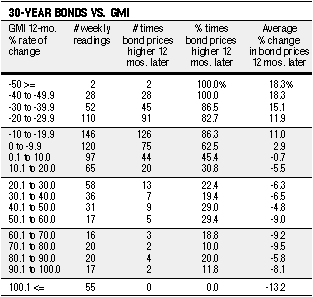A n article I wrote that appeared in the August 1994 STOCKS & COMMODITIES focused on bond fund investing and detailed a simple bond market timing model that signaled when to switch between long-term bond funds and short-term bond funds. This article will update the results of that timing model, present a new version that appears to enhance results as well as impart information on other ways to take advantage of the timing signals it generates.
Bond prices rise and fall inversely to interest rate movements, and long-term bonds experience greater price volatility than short-term bond funds. Ideally, when interest rates are falling, a trader or investor will be in long-term bonds to maximize price appreciation, and when interest rates are rising, in short-term bonds or even money market funds to maximize capital preservation and to reinvest more quickly. I have found that changes in inflationary expectations identify points in time when the odds significantly favor a rise or decline in interest rates during the next 12 months.
The key determinant of bond price movements is inflation, or more precisely, investors' perception as to whether inflation will rise or fall. Because a bond's interest payment does not change over the life of the bond, a rise in inflation means that bondholders will be paid back with less valuable dollars. Thus, when inflationary fears strike, bond prices decline so as to increase yields enough to entice new bond buyers to accept this potential risk.
Historically, gold has been considered a hedge against inflation. However, the most useful gauge of inflationary perceptions that I have found is gold mining stocks. Most investors prefer to buy and sell stocks of gold mining companies rather than hold gold bullion itself. Thus, when inflation perceptions rise, speculators will aggressively buy gold stocks and drive up these mining share prices. Conversely, when inflationary fears are low, investors sell and/or avoid mining shares, causing mining share prices to drift lower. Monitoring changes in mining share prices provides a most useful insight into inflationary expectations, and by extension, the likelihood for higher or lower bond prices.
Figure 1 depicts the price action of 30-year bonds in the 12 months following a given 12-month rate-of-change level from 1978 through November 25, 1996, for Barron's Gold Mining Index (GMI). The bond price index I use is a continuous price series that simply averages the weekly closing prices for the three nearest Treasury bond futures contracts traded on the Chicago Board of Trade (CBOT). I refer to this continuous series as the Treasury bond futures index (TBFI).Figure 1: Here's the price action of 30-year bonds in the 12 months following a given 12-month rate-of-change level from 1978 through November 25, 1996, for Barron's Gold Mining Index. The bond price index is a continuous price series that simply averages the weekly closing prices for the three nearest Treasury bond futures contracts traded on the Chicago Board of Trade.
As an example of how to read this table, refer to the fifth line of data in Figure 1. There have been 146 weeks that ended showing the GMI falling between 10% and 19.9% below its year-earlier level. Following 86.3% of those readings, long-term bond prices stood higher 12 months later, with an average gain of 11.0%.
